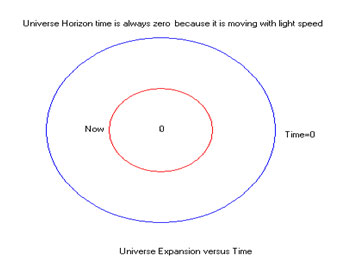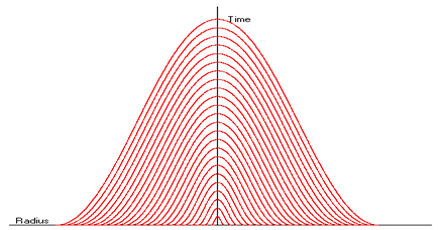Time Distribution in the world
As the world was growing, the time was increasing in its
center but since it was expanding with the Sf or light speed, time
at the edge remains zero obviously. Time has the maximum value at the center of
the world.




Fig. 11- Universal time is Max at center
The time distribution determines that time in our galaxy is less than the time in center and is more than new galaxies created in outer area.

Fig. 12- Time is distribution versus distance from origin
This time variation depends on speed of the world expansion, and could be formulated as follows

Our galaxy is not at distance of 13.7 Mil years from the world center, but using Fig 5 the local time is approximately 37 Mil years then it is possible to calculate (d) for a universal time Tr ≅58 Mil years which is approximately 47% of the world full current radius. It is clear that Sf is function of (d) distance from the world center.
If an object is observed using time calculations then depending on the object position relative to our position and also the world center, same distances would be seen different.
Any object radiating energy with a defined frequency on earth, if moves toward the center of the world its frequency will increase and if goes toward the horizon then its frequency will be decreased.
Spinning of Omegas , TAs and sub particles to galaxies also decreases while they are getting far from origin.
The world expansion frontiers could not have any radiation with any frequency. It could be concluded that the world horizon have not any mass or energy, but after frontiers the TAs such as light or others have physical effect on the outer worlds! (If anything exists)
Since if there is any other world outside this world, because there is void wall between us, then there could not be any transmission between them (No media). Even gravity cannot pass this wall.
Nothing can pass void (it has no time and space) except Dims and their children Omegas (to expand the world).